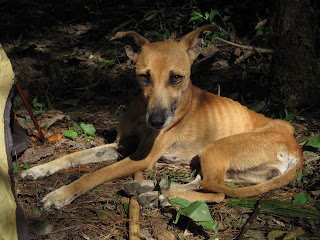In the morning we hired a mototaxi or tuk-tuk that took us to the park entrance, struggling over the deeply rutted dirt road, threatening to turn over several times, and bursting its front tire.









That day we climbed up through pretty second-growth forest and along a traverse intersected by small creeks in one of which Hilary found the long tail feather of a resplendent quetzal, sadly our only brush with one so far.
That night we camped at a site being built by brothers Juan and Chentío. At first we were sad not to be alone but they turned out to be friendly and interesting. Chentío hacked out a flat space for our tent with his machete and we cooked dinner around a fire and talked. Chentío told us about his plans to hobo his way through Mexico on the freight trains, pay a coyote $1,500 to smuggle him into the U.S., and make his way to Virginia to work with another brother on a horse ranch. We also talked about the recent elections and listened to the legislative debate on the radio. We made friends with their skittish and painfully skinny dog Sorpresa by feeding her cheese.






The following morning we rose rather late and took a walk through the forest to a view of a waterfall, looking in vain for a quetzal.
On our second morning we woke before dawn and got going shortly after first light, heading steeply up into the mystical cloud forest. It was like a jungle in the density of the flora, but the feel was completely different, cool, calm, and pleasant where a jungle is sticky and stifling. It reminded me of hiking in the old-growth redwood groves of California. A state of twilight exists on the forest floor at times with only chance shafts of light illuminating a flower or leaf. In other areas the whole scene is shimmering with dappled light and shade. At one point Hilary pointed up and noted that tree tops fit together as neatly as a jigsaw puzzle. In other places the canopy was densely grown and interconnected with lichens, bromeliads, ferns, and things I don't have names for bursting and billowing everywhere. The sense of enormous elapsed time from layer upon layer of growth is profound and beautiful. We stopped often to marvel at the incredible variety of things to see, some giant, some small, each place different. But the things that make a cloud forest so magical to walk through, the brooding dimness set off by shafts of brilliant light, make it nearly impossible to capture with a camera. I'm afraid I didn't do it justice.
On our way down from the summit of Cerro Las Minas we ran into a guy named Thomas who is riding his bicycle from Alaska to Tierra del Fuego, climbing the highest peaks in each country along the way, and raising money for Doctors Without Borders. He was friendly and, as you might imagine, in great shape. He did in one day what it took us three to do. It was really impressive. I got the feeling that he might be living ten lifetimes to my one. We have his blog listed to the right.
Our final day in the park we followed the Sendero El Gallo (Rooster Trail) along a ridgeline, sometimes as sharp as a knifeblade. It was different from the cloud forest, covered in dry pine, less dense, and sometimes opening up into beautiful views of the park and down into Gracias. It reminded me a bit of the northern Sierras of California.
































As we walked out along the Rooster Trail, took another tuk-tuk that burst another tire, and the following day made our way to El Salvador, I thought a lot about Thomas and what he is doing. I remain impressed but I have to admit I don't really understand it. But would he understand what we are doing, meandering our way home with no battleplan, no checklist, no distinct goal? Does it make any sense?
I'm not sure, but I think it does. Of course we have learned a lot and I hope grown a lot. But also we have been able to enjoy a kind of freedom that we may never have again. Not just the freedom from responsibility and plan. But the freedom of being able to be in a place and to have the time to really see it, to know it. As Tom Winkler poetically put it, we have the freedom to travel "the Road to Find Out." And we have seen many things, found out many things, many unexpected and unlooked for.
Here are some of the things we had an opportunity to see, wonder at, and get to know in our time in Celaque. I'm not sure if they, or any of the things we have seen in the past year, add up to anything or lead to some action or plan or future purpose, but I feel overwhelmingly lucky to have had the time to see them and make them part of us.






























No comments:
Post a Comment